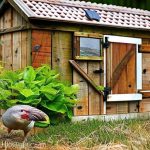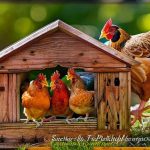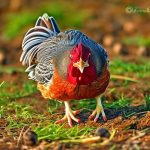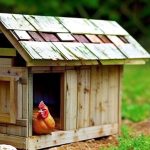Quail and chickens are common choices for backyard poultry farming, offering relatively low-maintenance care and providing sustainable sources of eggs and meat. Quail are smaller birds that produce delicate, flavorful eggs, while chickens are larger and valued for both their eggs and meat. Although quail and chickens can coexist in the same general environment, it is crucial to understand and accommodate their differing space requirements and maintain appropriate separation between the species.
Quail are characterized by their small size, docile nature, and adaptability to confined spaces. They are frequently housed in cages or aviaries, making them suitable for urban or small-scale farming operations. Chickens, in contrast, require more extensive areas for roaming and foraging.
They are typically kept in larger coops or allowed to free-range. To ensure a productive and harmonious environment for both species, it is essential to comprehend and address the specific needs of quail and chickens in terms of housing, nutrition, and care.
Table of Contents
- 1 Understanding the Space Requirements for Quail and Chickens
- 2 Factors to Consider When Determining the Distance Between Quail and Chickens
- 3 Benefits of Keeping Quail and Chickens at an Appropriate Distance
- 4 Potential Issues of Keeping Quail and Chickens Too Close Together
- 5 Tips for Creating the Ideal Environment for Quail and Chickens
- 6 Finding the Right Balance for Keeping Quail and Chickens
- 7 FAQs
- 7.1 What is the recommended distance to keep quail and chickens apart?
- 7.2 Why is it important to keep quail and chickens a certain distance apart?
- 7.3 Can quail and chickens be kept in the same coop?
- 7.4 What are the potential risks of keeping quail and chickens too close together?
- 7.5 Are there any benefits to keeping quail and chickens apart?
Key Takeaways
- Quail and chickens have different space requirements due to their size and behavior
- Factors to consider when determining the distance between quail and chickens include their size, behavior, and the availability of resources
- Keeping quail and chickens at an appropriate distance can reduce competition for resources and minimize stress
- Keeping quail and chickens too close together can lead to aggression, disease transmission, and increased stress
- Creating the ideal environment for quail and chickens involves providing separate areas for feeding, watering, and nesting to meet their specific needs
Understanding the Space Requirements for Quail and Chickens
Quail Space Requirements
Quail are ground-dwelling birds that prefer to stay close to the ground and are not known for their flying abilities. As a result, they require less vertical space compared to chickens. Quail also prefer to have hiding spots and areas to nest, so providing them with appropriate shelters within their space is important.
Chicken Space Requirements
Chickens, on the other hand, are more active birds that require more space to roam, scratch, and forage. They also have the ability to fly short distances, so providing them with enough vertical space is crucial to their well-being. In addition to space for movement, chickens also need nesting boxes and perches within their coop or environment.
Creating a Comfortable Environment
Understanding these space requirements is essential for creating a comfortable and healthy living environment for both quail and chickens. By providing the right amount of space and necessary features, you can ensure the well-being and happiness of your birds.
Factors to Consider When Determining the Distance Between Quail and Chickens

When determining the distance between quail and chickens, there are several factors to consider to ensure the well-being of both species. One important factor is the potential for disease transmission between quail and chickens. Keeping them too close together can increase the risk of spreading diseases such as coccidiosis or respiratory infections.
It is important to keep them at a distance that minimizes the risk of disease transmission while still allowing them to coexist in the same environment. Another factor to consider is the potential for aggression between quail and chickens. Chickens can be territorial and may exhibit aggressive behavior towards smaller birds such as quail.
Keeping them at an appropriate distance can help minimize the risk of injury or stress for both species. Additionally, considering the space requirements for each species is important for ensuring that they have enough room to exhibit natural behaviors such as nesting, foraging, and dust bathing.
Benefits of Keeping Quail and Chickens at an Appropriate Distance
Keeping quail and chickens at an appropriate distance from each other offers several benefits for both species. By maintaining a suitable distance, the risk of disease transmission between quail and chickens can be minimized, promoting the overall health and well-being of both flocks. This can help reduce the need for medical intervention and promote a more sustainable and natural farming environment.
In addition, maintaining an appropriate distance between quail and chickens can help reduce the potential for aggression and stress between the two species. This can create a more harmonious living environment, allowing both quail and chickens to exhibit natural behaviors without fear of aggression or injury. Providing each species with enough space also promotes better overall welfare, leading to healthier and more productive birds.
Potential Issues of Keeping Quail and Chickens Too Close Together
Keeping quail and chickens too close together can lead to several potential issues that can impact the health and well-being of both species. One major issue is the increased risk of disease transmission between quail and chickens. Both species are susceptible to different diseases, and keeping them in close proximity can increase the likelihood of spreading infections.
This can lead to higher mortality rates and decreased productivity in both flocks. Another potential issue of keeping quail and chickens too close together is the risk of aggression and stress between the two species. Chickens may exhibit aggressive behavior towards quail, leading to injuries or even death.
This can create a stressful environment for both species, impacting their overall welfare and productivity. Additionally, overcrowding can lead to increased competition for resources such as food, water, and nesting spaces, further impacting the health and well-being of both flocks.
Tips for Creating the Ideal Environment for Quail and Chickens

Separate Living Spaces
When housing quail and chickens together, it is essential to provide separate living spaces for each species to minimize the risk of disease transmission and aggression. This can be achieved by using separate coops or aviaries within the same overall environment.
Meeting Their Basic Needs
In addition to providing separate living spaces, it is crucial to ensure that both quail and chickens have access to appropriate shelter, nesting areas, food, water, and space to exhibit natural behaviors. Providing ample space for both species to roam, scratch, dust bathe, and forage is essential for their overall well-being.
Maintenance and Hygiene
Regular cleaning and maintenance of their living spaces is vital for preventing disease transmission and promoting a healthy environment.
Finding the Right Balance for Keeping Quail and Chickens
In conclusion, keeping quail and chickens at an appropriate distance from each other is essential for promoting the health, well-being, and productivity of both species. Understanding their specific space requirements, behavior, and potential issues of keeping them too close together is crucial for creating a harmonious living environment. By providing separate living spaces, minimizing the risk of disease transmission, reducing aggression, and ensuring access to appropriate resources, it is possible to create an ideal environment where quail and chickens can coexist in a sustainable and productive manner.
Finding the right balance in keeping quail and chickens at an appropriate distance is key to successful poultry farming while promoting the overall welfare of both flocks.
If you’re considering turning a shed into a chicken coop, you may also be interested in learning about the best practices for keeping quail and chickens together. Check out this article on Poultry Wizard for tips on creating a suitable living space for your birds.
FAQs
What is the recommended distance to keep quail and chickens apart?
The recommended distance to keep quail and chickens apart is at least 50 feet. This helps to prevent the spread of diseases and reduces the risk of aggression between the two species.
Why is it important to keep quail and chickens a certain distance apart?
Keeping quail and chickens a certain distance apart is important to prevent the spread of diseases. Quail and chickens can carry different diseases that can be harmful to each other, so keeping them apart reduces the risk of transmission.
Can quail and chickens be kept in the same coop?
It is not recommended to keep quail and chickens in the same coop. Quail have different housing and environmental requirements compared to chickens, and keeping them together can lead to stress and aggression.
What are the potential risks of keeping quail and chickens too close together?
Keeping quail and chickens too close together can increase the risk of disease transmission, stress, and aggression between the two species. This can lead to health issues and reduced productivity in both quail and chickens.
Are there any benefits to keeping quail and chickens apart?
Keeping quail and chickens apart can help to maintain the health and well-being of both species. It also reduces the risk of disease transmission and allows for better management of their individual housing and environmental needs.
Meet Walter, the feathered-friend fanatic of Florida! Nestled in the sunshine state, Walter struts through life with his feathered companions, clucking his way to happiness. With a coop that’s fancier than a five-star hotel, he’s the Don Juan of the chicken world. When he’s not teaching his hens to do the cha-cha, you’ll find him in a heated debate with his prized rooster, Sir Clucks-a-Lot. Walter’s poultry passion is no yolk; he’s the sunny-side-up guy you never knew you needed in your flock of friends!







